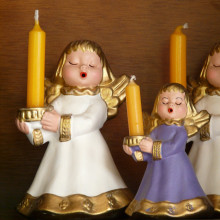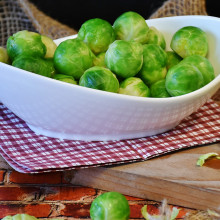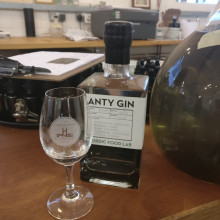A Very Naked Christmas
This week, The Naked Scientists are spreading festive cheer as they get ready for Christmas, all in one hour! Joined by psychologist Philipe Bujold, tech expert Alex Farell, vibrations engineer Hugh Hunt and plant development researcher David Hanke, Chris Smith and Georgia Mills tackle the physics of carol singing, firing up the christmas snacks - literally - and, whether you like them or loathe them, the biology of brussels sprouts.
In this episode

02:40 - Why do Christmas trees drop needles?
Why do Christmas trees drop needles?
with David Hanke, University of Cambridge
The first thing we need to do for Christmas is put up the Christmas tree! Sadly, Chris Smith and Georgia Mills only had a plastic one but there’s nothing quite like a real Christmas tree... Even if their needles do make a bit of a mess of the carpet! It was over to plant researcher and ecologist, David Hanke, from Cambridge University to explain just why trees drop their needles.
David - In brief, it’s an emergency crisis response to the loss of the roots, and it’s not simply because you deprive them of water. Putting the Christmas tree after you’ve chopped the roots off into a bucket of water makes absolutely no difference to it shedding the leaves.
Shedding needles is a burnt-earth panic response to a loss of contact with the roots - so the needles panic. It’s a very active energy-dependent process. New enzymes have to be made to break down the base of the needle. More usually, this happens because of pathogen or herbivore attack that separated a section of the tree or a branch from the roots. The needles contain all the nutrients that the attacker is after. There’s not much worth eating in the rest of the tree frankly, so they’re ditched in order to starve the enemy.
Georgia - Oh wow! I’m feeling quite guilty now about sending all these Christmas trees into panic mode when we put them in our house. Is there anything we can do to keep their needles on?
David - Ahh no! Nobody has ever found anything. The only thing we can do about it is selective breeding because there’s a lot of variation out there in tree populations in terms of their resistance to needle abscission as it’s called.
Chris - Can I ask a question then because you said this is an active process, David, that the tree has to make an enzyme to then literally sever the needle from the tree. So if you were to say steam treat your tree at a really high temperature with steam and kill it, would the needle then stay stuck on albeit the tree’s dead?
David - It would stay on.
Chris - That’s the answer then, you just have to steam treat your tree. You need a big steamer.
David - You need a big steamer and the whole thing might start to smell after a relatively short period of time. I would just worry what you’d do with a cooked Christmas tree. Do you know what happens to needles when you cook them?
Chris - Hugh?
Hugh - So you’re saying it doesn’t matter whether you put the tree in water or not?
David - Well, slightly. You can slow down the process to a very limited extent and really only if you’ve got one of these types that shed their needles very quickly then putting it in water will slow it down. But if you’ve got a type that has high resistance needle abscission that’s going to give you 60 days it doesn’t matter, it won’t make any difference.
Georgia - So we're obviously getting through our Christmas trees quite quickly, so what's the best way to grow a Christmas tree?
David - Very important, because Christmas trees tend to be grown on extremely poor soil, so you need a nice fungus in there that is going to be able to recover scarce mineral resources, especially phosphorus in the soil, and relay them onto your tree.
Georgia - So there’s a fungus underground sort of helping the tree grow?
David - There is indeed. And the tree is helping the fungus by supplying it with the carbohydrates that it needs for energy.
Georgia - That’s very kind of it. Does it get anything in return?
David - Yes. It gets sugars from the tree, so all its energy and carbon supplies come from the tree. They live together.
Georgia - If this fungi helps the tree nice and green, what about making sure it’s that nice Christmas tree shape we all know and love?
David - It depends what you mean by nice. This is a very subjective judgement here. If you’re German or on the continent then your nice Christmas tree shape consists of tiers of horizontal branches with a big space in between because you want to hang your decs into the spaces in between.
Until the middle of the 20th century almost all Christmas trees grew like this. Now growers reported a change in the shape progressively, but eventually we’ve sussed it out that when you mis-spray these trees with ammonium nitrate as a supply of nitrogen, you get a big increase in the level of the hormone called cytokinins. It’s the cytokines that make lots of otherwise dormant buds grow out and become branches. So you fill in those spaces with lots of branches, you end up with a bushy tree as a result and, actually, bushy trees are much favoured by the Americans because they prefer to wrap their decs around the outside of the tree. They’re very happy with the new busy trees.
Chris - Philipe is nodding in agreement, so you like a nice bushy tree?
Philipe - Yes. I need a very, I wouldn’t say leafy but spiny tree I guess. Although, I was thinking as you were talking it seems very complicated to have a Christmas tree. You need to actually grow it and you need the fungus and everything, couldn’t we just have a bunch of maple trees? Not stereotypically Canadian or anything but, what if we cut maple trees and all have Christmas tree made of maple and maple syrup at the same time?
Chris - Yeah. Why do we have to have Christmas trees David? Where’s that come from?
David - Ah. Because of Prince Albert really. He brought them over from Germany. What you need is to bring in an evergreen. It’s the most magic of evergreens because they are still green when everything else is dead and looks awful. We actually use a lemon tree. It grows in a pot and the leaves of a lemon tree, as you will know, are one of the only citrus plants that actually has the oil, the essential lemon oil in the leaves. What you can do is trim the leaves off and you wrap them around your sea bass on Christmas eve and wrap it up with foil and cook it, and you have the most delicious Christmas eve meal. Get a lemon tree, don’t bother with a spruce tree.

08:26 - The Entropy of Christmas Lights
The Entropy of Christmas Lights
with Hugh Hunt, University of Cambridge
For most of us, it’s a trip to the attic to dust off the decorations and get to those lovely twinkling lights out. Now, you’re absolutely SURE, if you’re anything like Chris Smith, that you put them away in a highly organised, nice neat pile last year. But no! They’re tangled in one big lump. It’s not rocket science it’s just physics. Entropy, specifically, as Hugh Hunt explained...
Hugh - This idea of tangled mess of things is disorder. If you’ve got things really nicely ordered, then so long as you’re very careful, they stay ordered. But once they become disordered it’s really hard to get them back again so, for instance, if you spill some water or if you break a plate. This idea of entropy is, it’s a measure of disorder and if you’ve got something like a gas like air, then it turns out that the equations to calculate the entropy are not too difficult. But when it comes to Christmas lights the equations aren’t quite so straightforward.
I’ve got a balloon here, I can blow it up… and the air is in that balloon, and if I’m very careful the way I let it out, I could get all the energy to come out carefully. Now if I’m careful about it I can get a lot of the energy back again, but if I blow up my balloon and I’m not so careful, I’ve just lost all the energy all at once. What’s happened is it’s a very disordered way of getting the air out of the balloon.
Chris - Can you explain to me what this has got to do with my Christmas lights?
Hugh - What you’ve got to think about is that you’ve got to be careful like with the balloon. If you want to get things back how they were to start with you have to be careful. Entropy can be measured but you can use common sense and be very careful. Wrap your lights up carefully so that you get them back to how…
Chris - Many people say that they did wrap their lights up carefully. Is what you’re saying that, basically, the whole system is that there’s one organised way to have your lights, but there are many many ways to have your lights in a disorganised way so, the odds are, that they’re not going to stay organised for very long unless you take enormous steps to make sure?
Hugh - The worst thing you can do is put more than one set of lights into the same bag because sure as…
Chris - Yes, been there done that.
Hugh - … they’re going to be get tangled up with each other and that’s the worst bit
Georgia - Well speaking of, we actually have some tangled lights here that the Naked Scientist producers have found in their house. So we thought for a fun Christmas activity we could use you guys to help us untangle our lights, and we’ll have a little competition.
Hugh - Is that the only reason you have us along?
Georgia - Yeah, pretty much.
Chris - So everyone’s getting a set of fairy lights.
Hugh - God! This one’s terrible.
Chris - Everyone is busy beavering away trying to get these lights untangled and some people are having some success. Philipe; you’re looking like you’re being reasonably successful there, you’ve got most of the knots out of yours. These genuinely just came out of people’s cupboards, didn’t they, Georgia? These were just found like this?
Alex, it looks like you’re making them more tangled up.
Alex - No. I’ve nearly done one of them.
Chris - She’s nearly got one big tangle out. Hugh’s got the worst. You’ve actually added disorder to yours.
Hugh - But the thing is that I can’t find the bloody end. And I think that’s the thing you were saying Chris, if the chain is really long then there’s many many more end states. If you’ve got a really short piece of string, it’s really hard to tangle a short piece of string.
Chris - David’s there first. He did have the shortest strand of lights.
David - Did I?
Chris - Yeah.
David - No.
Georgia - Philipe’s done as well.
Hugh - So, all I would say is that once they’re untangled you’ve got to get something like an old cereal box or something and wrap them around the outside of the cereal box. Give them something that they can stay attached to.Stuffing them into a bag, they’ll be exactly like this again next year.
Chris - So the bottom line is that entropy is all about things becoming more disorganised. There are lots of ways that the fairly lights can arrange themselves to be disorganised; there are very few ways they can arrange themselves to be organised.
Everyone’s still going at this Georgia.
And, as a result, unless you take steps to make sure they stay well organised then you’re going to have trouble Hugh? So to put them round a piece of cardboard or something which confers order on them and stops them having those degrees of freedom? We now have wrapped fairy lights that are flashing.
Hugh - I know. I saw that. You are very sparkly! It’s all very well to have a system but, if the person who finds the lights the following year doesn’t know your system…
Chris - That is true. There’s a great gift idea in this Alex?
Alex - Self-untangling fairy lights?
Chris - Fairy lights that don’t get tangled and then some system that stops them tangling up again - that confers order and reverses the effects of entropy.
Alex - Absolutely.

14:16 - Decisions, decisions!
Decisions, decisions!
with Philipe Bujold, University of Cambridge
Time for some Christmas shopping but how do we decide what to buy? And are the shops pulling on our string? Georgia Mills asked psychologist research student, Philipe Bujold, why it's so difficult to make decisions whilst shopping.
Philipe - First of all, keep in mind that you’re taking advice from someone currently wearing Christmas lights. But yeah, it’s really hard to make a decision basically because of the way the brain is made. As opposed to a computer which can store enormous amounts of data, the brain is really powerful because it takes a lot of shortcuts and one of these shortcuts is basically that the brain will always try to represent the lowest amount of information at a time. The way it does that is by using references and these references are always from memory. And that’s a really efficient thing that the brain does because when it uses references it only has to encode a tiny difference in value.
So our brain is really good at making these tiny choices but, the issue with making these choices then becomes, as soon as you switch that reference, then your economic rationale breaks down. I have a really good example for this and how you can make choices really difficult. Think about the cinema for example. You can have let’s say a small popcorn or a large popcorn. Let’s say the small one is £3, the large one is £7. Most people in this case would go with the small popcorn because its £3 and you can probably buy two for the price of the large one. But, if you reverse the context, and add an extra choice which makes it a lot more difficult. You add a medium and let’s say the medium is £6 instead of the £7 or the £3. That makes the £7 larger one a lot more appealing. You’ve only a’ decoy’, which we call in neuroscience, and all of a sudden you’ve switched people’s preferences.
So choices are really good and you’re very good at maximising these choices in different contexts but, unfortunately, because we have so many choices and so many contexts then we aren’t that rational after all.
Georgia - I see. And I know the Christmas shops sometimes exploit this. You went Christmas shopping with fellow Naked Scientist Lewis Thomson earlier in the week so let’s hear how you guys got on…
Philipe - The brain isn’t the best computer we can think of. What it tries to do is always simplify, simplify, simplify. So it’s going to try and adapt its range when it codes values of the decisions we’re trying to make, and it’s going to try and adapt that round a central value that we build around our memories, so we call that a reference, for example.
From this reference point, your brain is going to try and compute what is gains and what is losses. What the store is going to try and push on you is this idea that you’re winning all the time and it’s going to set that from a reference. If you have a reference that’s let’s say a £2 pack of strawberries, what you can do from there is basically reduce the price and say it’s on sale, so the person feels like they’re winning because they’re spending less money, they’re keeping more money and they’re getting the strawberries in addition.
Lewis - I see the wine is on sale, shall we go and get some?
Philipe - You see, even when you know you still fall for it. Let’s go.
Lewis - We’re at the wine section now. There’s quite a lot of choice though, and I don’t know much about wine. How is my brain making this decision?
Philipe - There is a lot of choice in the grocery store at the moment and that is a big problem that people have also. That’s one of the situations where your brain is going to try and use the shortcuts that I was talking about earlier where you try and build a reference with your memories, and you try to use different markers that you can use in decisions in the past to try and make the best out of your current choice.
One of those examples would be price. Price for wine is a very very big indicator because regardless of the quality of the wine, people will tend to associate a certain value just based on the price. That’s actually been shown in a lot of neuroscience studies where if you increase the price of a wine that you’ve tested earlier, you actually see a brain signal increase in value sections of the brain. So it’s not just psychology at this point, it’s not just behaviour, you actually have a biological basis for it. What people try to do is go with the wine that’s either the second cheapest option or the second most expensive option, because you don’t want to go with either extreme, but you want to still use this reference to guide your decision. That’s one thing that grocery stores till try to do, they’ll put the average price at eye level and then everything else will be either above that or under that and you’ll use that reference to then compute your gains or your losses and make your choice.
Georgia - Why does buying things sometimes make us feel pretty good about ourselves when we’ve been shopping?
Philipe - The answer to that, contrary to popular belief, not dopamine; it’s actually what we call endorphins. Endorphins are opiates that you have in your brain that are naturally released. Think of opium, for example, it’s based from that drug, and opiates make you feel pleasure and that’s what you derive when you buy something. But, when Christmas comes, you also have the anticipation effect, and anticipation combined with dopamine, which is now its role is a lot more powerful than pleasure itself. So there’s two systems: endorphins and dopamine that regulate this pleasure and this anticipation of pleasure.
Georgia - Ah, I see. So you’re looking forward to this rush you’re going to get when you buy something?
Philipe - Exactly. And that’s what December is all about.
Chris - But Philipe, have you got all of your gifts then? This retail expert and psychologist of gift giving, have you completed the goal of gift buying?
Philipe - This is when people realise they should not listen to me. I have the advantage that I’m an immigrant. I’m from Canada, which means that, unfortunately, it’s really hard to give gifts to Canadians, but also means that it’s really good for my bank account. So, no, I have not bought things yet.
Chris - Are you saying you’re a scrooge, you’re just stingy?
Philipe - I wouldn’t say that. I would say I’m an expert on decision making.
Chris - Very good. Well I’ll try that on my wife and see how that goes down.

20:03 - Can technology help buy the best gift?
Can technology help buy the best gift?
with Alex Farell, GiftWink
Can technology choose the best gift for your relative? CEO of Gift Wink, Alex Farell, told Chris Smith how her company is doing just that...
Alex - Yeah. I run a gifting platform and it uses data and relationship data on finding the perfect gift. Because, I think, these days we live our lives online, and we have a big social footprint online, and gifting isn’t the normal retail experience where you’re buying something for yourself. It’s much more complex than that, you’re buying for someone else so there’s two different sets of personal data and preference data in there, so it’s actually a very complex journey buying a gift, far more complex than people realise.
Just hearing whether people have done their Christmas shopping. The data around it’s really interesting around Christmas gifting because certain age segments buy very early. The older generations tend to buy in October. The grandparents have got their gifts sorted by then. Men and women can get very close to the bone and be shopping on Christmas eve, that’s not necessarily a gender thing.
Chris - Yeah, I’m one of them.
Alex - Me too, exactly. So there we go, we’re both in the same segment. Bigger items, bigger gifts are bought quite early on. If you haven’t bought them by the end of October then they’ve normally gone. It’s the smaller items that then go later.
Chris - The company’s called Gift Wink?
Alex - It is, yes.
Chris - How long’s it been going?
Alex - Our company’s been going for about two years, and we think we can get the perfect gift.
Chris - How did this start; was this just your brain child and you set this up and you’ve scaled it? What’s the story?
Alex - The story is I used to run a different platform. I used to run a tech careers platform which was a much drier topic. We matched IT professionals with the right job, so I figured we could do the same thing with gifts. It’s a bit more of an interesting journey because gifts are highly emotional. There’s a big emotional investment when you choose a gift for somebody and the reason why I started it is - I’ve got a bit of a confession to make -I’ve got one niece but I can never remember her birthday and I could never figure out what to buy her.
Chris - So tell me the user journey or the user story? Someone comes to the website - what happens?
Alex - We ask you a bit about who you’re buying for; their age and gender; what they’re into, and then we serve shorter bursts of the perfect gift so we say: here’s the five things your mum will love.
Chris - How does your system know that my mum will love that?
Alex - It depends on the questions we’ve asked. There are age and gender categorisations. The relationship label is quite key actually - if I’m buying for say three different women in my life say, a girlfriend of mine, versus my sister, versus my mum. Even though those are three women I’m buying for of not particularly different age groups, the emotional investment in those three different relationships is significantly different. And the price point is different for a friend versus my mum versus my sister, so just the relationship label in itself drives a different segment of gift suggestions. If you add in then a blend of age and gender data ,whether they’ve got children, whether they haven’t got children, what they’re family groupings look like, then you're halfway towards getting a better gift selection for them.
Chris - So the system says right, you’re buying for a ten year old girl and she’s interested in this sort of thing, and it’s going to offer you some options. Are you then closing the loop, you’re saying when we present those options to a potential purchaser, they tend to click on these things and not those ones, so those must be things that are appealing to, in their mind, a 10 year old girl, therefore increase the emphasis we place on those in the next sale, and the next sale? Is that what you’re doing?
Alex - Yeah well what we do, there are different gifting occasions and motivations, so if I can buy for my own children versus buying for other people’s children , if it’s a birthday versus a Christmas gift, so the occasion itself is different from a price point perspective; the relationships are different.When we have asked those questions, we serve a list of content to our customers, we then have the ability for them to tick and cross which ones they like as they go along. So we know oh, they’re liking that, they’re not liking that, and we can serve them better match content, so we learn as we go along what they’re into and then we can serve them more of what they like and less of what they don’t like.
Chris - So are people really getting a genuine ‘it’s a good gift selection’ or is it just who you happen to be working with as your supplier?
Alex - We’ve got now, I think, 8,000 gifts listed so we’ve got a lot of gifts. It’s important to go and find out what people want, so what's interesting when you buy gifts for children, for example, is they tend to be very heavily into a brand. Whereas when you’re talking about what people are into when they’re adults, they tend to be more category based so they’re really into cooking, or they’re foodie, so the labeling is different for ages and genders.
To have a perfect gifting experience you’ve got to have discovery brands, mainstream brands, you’ve actually got to have a blend of everything, because buying for children is very different from buying for adults. So, 8,000 gifts might sound like a lot but if they’re only into food, and only that kind of food because I’m gluten intolerant then, suddenly, you need a lot of inventory on your site.
Georgia - Alex, I’m intrigued. A lot of people really like cool, brand new tech for Christmas - I know my dad certainly does. What’s been exciting in tech in 2017; what kind of tech presents do you think people are going to be getting this year?
Alex - There’s some really big branded things that are coming out. There’s some new games consoles that are very clever and there’s all that kind of stuff. Virtual reality will play a big part in Christmas gifts this year I think. You’ve all seen the headsets; they’re getting better and better, so I think there’ll be quite a lot of that going round.
I’ve seen some very cool stuff, some drones that you can control with your hand gestures. It’s very minority report, so actually as you move your hands the drones move and I think that will be something on everyone’s list this year.
Georgia - I’d like one of those.
Chris - Is that on your website?
Alex - That’s not on our website yet actually. It’s very high tech…
Chris - It will be tomorrow?
Alex - Exactly. And one other thing I was having a look at what’s really significantly innovative at the moment, and there’s a guy who’s very very close to releasing a car that actually turns into a plane. Back to the Future moment, that’s feasibly coming in the next 12 months.
Chris - And is that going on your website?
Alex - I don’t think that’s quite on there and I’m not sure it would fit under the tree, but it’s definitely one to keep an eye out for.
Chris - You’re supposed to say it’s ‘flying off the shelves.’
Alex - It’s absolutely flying off the shelves that one, groan...

26:20 - Making music sound nasty or nice
Making music sound nasty or nice
with Hugh Hunt, University of Cambridge
The tree is up, the presents have been bought and it’s almost time for the big day itself. But whether you sing like a cherub or you screech like a cat, what’s Christmas without a few carols? With help from the Cambridge University Music Society singers, Chris Smith hears about the physics of sounds, songs and singing from engineer, Hugh Hunt...
Hugh - Sound is all about vibrations in the air. If you think of waves in water or… well, I’ve got a slinky spring here...
Chris - I’ve got a giant one here to play with!
Hugh - One end of the slinky spring is attached to a brick, as it happens, and I’m holding the other end on the table and I’m wobbling the end backwards and forwards, and I’m getting a wave. It’s going at a sort of a speed like one…
Chris - And just to explain for people at home what we’re seeing. At one end of this long table we’re all sitting around, Hugh has a house brick, which he has tied to his slinky spring. He has stretched the slinky spring 2 or 3 metres to the other end, and is now shaking the other end which he’s holding and it is making this wafting motion backwards and forwards in time with the metronome you’ve got beating on the desk.
Hugh - And it’s just one curve. But if I double the speed that I’m shaking the end of the slinky so instead of one, one, one - one two, one two, one two.
Chris - Ah, that's interesting. What we’re now seeing is that there’s a point roughly in the middle of the slinky which is now not moving but you’ve got two little waves either side of it going up and down.
Hugh - That’s right.
Chris - We’ve got two waves where previously we had one. So you’ve doubled the frequency, the rate at which you're doing it and you’ve now got twice as many waves.
Hugh - It’s called a “standing wave”. Now if I do three times: one two three, one two three, one two three...
Chris - Yes. We’ve got three points along the slinky which are not moving, and three little wavelets either side of those.
Hugh - And I can do four - one two three four, one two three four, one two three four…
Chris - And it’s called a “standing wave” because when I look at this it looks like there is a wave standing still in space almost?
Hugh - Exactly. If you think of waves in water, you would see the wave moving along in the the distance, but a standing wave doesn’t appear to be moving at all. These are called “harmonics.” The first one was the fundamental, and the second harmonic, the third harmonic.
Chris - So the fundamental is the one, two, three and that’s just shaking backwards and forwards. The second harmonic is twice as fast.
Hugh - The third harmonics three times, the fourth harmonic is four times. If you think of the note on the piano - the note C, then an octave above it is another C, and that’s the first harmonic, double the frequency.
Chris - Right. So that second C is twice as many waves as the first C?
Hugh - That’s right. Then the third harmonic is then the G above that. And then the fourth harmonic is then the C above that, and then the fifth is E, then the sixth is G, then the seventh is B flat.
What we can do with the choir is we can sing them for you if you like?
Chris - Oh, lets do it.
Choir sings harmonics
Chris - That was lovely.
Hugh - There we go. We went up to the tenth harmonic there, and each one of those was progressively increasing the number of cycles of that slinky spring, if you like.
Chris - Why does it sound nice? Because it’s perfectly possible to get them, I presume, to sing something that doesn’t sound nice. so what’s the difference between ‘nice’ and ‘nasty’?
Hugh - When you have a general sound, you can decompose it into these harmonics. That’s why different voices might sound different or a french horn might sound different from a clarinet, might sound different from a violin, but they all basically have this same harmonic structure. But one thing that is really weird is that Bach figured out that you didn’t have to get these harmonics exactly right; that our ears are quite forgiving.
It turns out, rather curiously that if you start off with a certain note, and you double it, and you double it, and you double it, double it, double it. You could start off with the same note and do 1½ times it and 1½ times, 1½, 1½, 1½ and you ought to get to exactly the same note again after a while, but it doesn’t work, the maths of it doesn’t work. And it turns out that no matter how we might try it is impossible to get perfect tuning, and yet beautiful music can be made by instruments that we can’t get perfect tuning on.
Chris - So this is an artifact of the human auditory system that we like that particular combination of sounds and we don’t like it when the multiples don’t add up correctly?
Hugh - It’s something that we have got used to certain sounds, and then other cultures have got used to sounds. We can sometimes find music from other cultures just not particularly musical.

31:29 - Excitement: What's happening in our brain?
Excitement: What's happening in our brain?
with Philipe Bujold, University of Cambridge
It's all getting rather exciting and Christmas wouldn’t really be Christmas without the kids being up at the crack of dawn with excitement! Georgia Mills was joined by Psychologist, Philipe Bujold, who explained why we look forward to the big day.
Philipe - The short answer to that is that it’s all about memories. I was saying earlier that in December, it’s basically an entire process of remembering and anticipating what Christmas is going to be. It’s a reference-dependent system if you want. And the whole idea of Christmas is basically in your head. When you think about it December is amazing, but then when it comes to Christmas Day itself, it’s never as hyped up as what you’ve painted it be.
Chris - I think that’s the hangover, Philipe, that’s partly to blame isn’t it?
Philipe - After Christmas or?
Chris - Yeah. Do you not have that problem?
Philipe - I can’t say I have, unfortunately, but everybody’s looking at me oddly so maybe I’m the only one. The big principle you have to know about the brain is that cells that fire together, wire together and that means that, basically, every cell in your brain that fires at the same time at some point will be associated. It’s a very simplistic way of looking at the brain but that’s a bit of how memories work. So, whenever you hear a choir singing you’ll think about your childhood memories, you’ll think about the pleasure that gave you, and all of these circuits are firing and that’s what Christmas is. You’re remembering all these things and you’re anticipating it which means that dopamine is firing, and dopamine is actually very exciting.
What happens is that children have an amazing dopamine response. And this dopamine response is actually uncontrollable by the rest of the brain that’s developing. So children look crazy at Christmas, and they are actually going crazy because they just can’t contain this dopamine.
Chris - So it’s not just the E numbers?
Philipe - It’s not just E numbers, no. It’s really your children are going nuts!
Georgia - I do remember driving my parents nuts because I’d wake up at about 4am on Christmas like is it ready to start the day yet? Why does this make it hard to sleep; why do people sort of wake up really early with excitement?
Philip - Dopamine’s main effect, like I was saying, is anticipation. You’re predicting a reward and then you’re going to get a tiny prediction error which is basically going to correct your prediction via this dopamine signal, and this influences your attention. It’s going to wake up your brain to make sure that you’re planning and predicting as best as you could so it’s always going to tone down the sleepy parts of your brain, if you want. Then, especially for children, they have to infer everything that’s going to happen, whereas we have the advantage of having lived before and having memories that we can use to compute this prediction.
So children actually need to use their dopamine and the crazy amount of attention which wakes up their brain, so that’s probably why you were awake at 4am in the morning.
Georgia - Not any more; 4pm now I think I get up. When we’re sort of excited for Christmas it also can be quite a stressful day, I suppose. What’s going on in our brain with that as well?
Philipe - Anticipation is great but, unfortunately, something that happens, like you said, is stress. Stress, a result of it is going to be because of release of adrenaline, of cortisol. And that happens when we’re meeting family, that happens when we have to think about gifts, and that’s actually a really big stressor. It going to stop you from sleeping and it’s also toning your ability to recall, and your memory’s a bit lower also. So the stress is going to be a big issue for those people that are trying to buy all their gifts at the same time, that are going to try and remember all of their family names.
Chris - Especially if the mother-in-law’s coming over. That will be a big driver for cortisol stress hormone release!
Philipe - Yes.
Georgia - So get your presents in advance. Don’t forget your mother-in-law’s name. Any other tips for avoiding stress at Christmas?
Philip - Yes. If you can make a list of the things you have to do. That way you don’t have to remember them, because we can only remember at one time about 6 to 7 things that we can process actively. So try to make a list and that way you can remember or use a service that finds gifts for you.
Georgia - So make a list and check it twice!

35:22 - How does food give us energy?
How does food give us energy?
with Chris Brackstone, University of Cambridge
Now for the main event - the food! The turkey’s been cooking for hours, someone’s already pinched a few pigs in blankets and yet, somehow, you still find room to scoff a few festive treats. Izzie Clarke went to the Department of Chemistry to meet Chris Brackstone to explore how food gives us energy, and we should warn you; A few gingerbread men and some jelly babies were harmed in the making of this programme…
Chris - Okay. We’ve got a large test tube that’s got potassium chlorate in it, which is used as a source of oxygen, and a large burner underneath to make it molten and boil. That’s going to give us our heat source and our oxygen and our poor little jellybaby is going to give us our sugar. If we scale it up to what happens in our own bodies, we use sugars and our own internal heat source and the oxygen we breathe in to get energy from the glucose and the carbohydrates.
Izzie - It turns out when you drop a jellybaby into molten potassium chlorate a rather violent reaction kicks off…
Oh my goodness! I mean there’s nothing left of it.
Chris - No.
Izzie - It started off with a slow burner and then, all of a sudden, it got this amazing purple light. This isn’t exactly what’s going on inside our bodies is it, because we don’t all sort of burst into flames when we have a jellybaby?
Chris - We don’t no. But we do get a certain amount of energy from the sugar and there’s a whole process going on - we’re like a little chemical factory. We’ve obviously got far less oxygen in the atmosphere that we’re using. We’re a lot cooler and we ourselves need to slow the whole process down anyway. There are various biological processes going on that slows that whole process down and lets the energy release more slowly.
Izzie - The processes going on in our body to release energy are a lot slower. And this exploding jellybaby showed me just how much energy is in these sweeties even if, thankfully, we don’t go up in flames. So which Christmas calorific snack releases its energy in the most spectacular manner? We lined up the treats and put it to the test…
First up were some gingerbread men and, for this demo, Chris had prepared some liquid oxygen to speed up that burning process…
Chris - I’m going to pour that over the gingerbread men. Are you ready?
Izzie - I’m ready.
Chris - See how this goes…
Izzie - That was quite the send off. My goodness! We had a huge orange flame right in the middle of that. Our poor gingerbread men have been left - they’re rather barbecued.
Chris - They are. Plenty of calories I think.
Izzie - Plenty of calories. Okay. We’ll move onto the next one and see how the Christmas cake does…
Chris - I’ve never burnt Christmas cake before…
Izzie - It’s not as an intense flame as the gingerbread men. It was more of a slow burn right round the edges and it seems to be that it’s just the icing. The really sugary icing and marzipan that is really taking up in this flame.
Chris - Indeed. It definitely does, doesn’t it.
Izzie - So the gingerbread men are still in the lead at this rate. Let’s try our third and final test - the well loved mince pie…
Oh and they’re off! Oh my goodness! We’ve got little bits of pastry flying off at different corners. The flames going lots of different blues and greens and yellows and oranges. And those mince pies have been absolutely incinerated.
Why was that flame so much bigger than the other two that we saw?
Chris - Most of the moisture has gone out of them so it is pretty much just pastry and whatever filling was in there to start with.
Izzie - Was in there! It’s certainly not there anymore.
Chris B- There’s not much left is there? They’re very reminiscent of the last time I tried to bake anything I must admit.
Chris S - Note to self, don’t let Izzie near your kitchen. Alex - can tech save the day in the kitchen when you’re trying to prepare your christmas dinner in a hurry?
Alex - I saw two really cute new bits of tech recently that I think would make your Christmas day a bit easier. The first was an intelligent cocktail-making piece of kit that makes your favourite cocktail...
Chris S - That’s me!
Alex - … in under five seconds.
Chris S - Oh, I’m not that quick.
Alex - Exactly. So that’s the first bit I thought that was really really cute. The second bit, and now this is just for fun, was a butter knife that uses your body temperature to cut the butter if it’s cold straight from the fridge, which I thought was just genius.
Chris S - This is a knife at room temperature and it cuts butter out of the fridge?
Alex - It uses your body temperature to cut the butter straight from the fridge.
Chris S - That sounds like money for old rope. It’s like you hold a knife and warm it up and cut butter with it?
Alex - It’s probably one of those things that you get and you think I don’t know how I lived without it.
Chris S - I bet you owned one of those lock de-icers that you got for Christmas which you sort of slide that thing out and this long prong comes out and you put it in your lock in your car to de-ice your lock on a cold day. Did you have one of them?
Alex - I haven’t got one of those but if was going to prioritise one of the two I’d go for the cocktail maker.
Chris S - I owned one - I never used it. I’ve been dying for a cold enough day when the lock froze on my car and I could actually use it.
Hugh?
Hugh - Presumably that butter knife it must be a really good metal with a really good thermal conductivity - like silver. So maybe that explains why in the old days butter knives were made of silver.
Alex - Ah, there we go.
Chris S - Was it made of silver?
Alex - I don’t know. I’ll have to look that up. I’m sure it wasn’t because it didn’t look like it cost the earth, so I’m assuming it wasn’t made of silver.
Hugh - Maybe it’s made of something like uranium or plutonium, so it’s producing heat.
Chris S - Highly likely Hugh!
Alex - Oh dear, I’m worrying.

41:01 - The Science of Brussels Sprouts
The Science of Brussels Sprouts
with David Hanke - University of Cambridge & Sarah Castor-Perry
Moving on we get to the most controversial part of Christmas dinner: Brussels sprouts. But what are brussel sprouts and why do they look so weird? Georgia Mills put it to Plant Development expert, David Hanke.
David - Well, brussel sprouts are the dormant swollen side buds along the stem of a relative of the cabbage. But, because they’re an over-wintering structure, they’re completely dormant, and that’s neat because it means that after we pick them they stay in a kind of pristine state because they’re not metabolising, they’re not going to go downhill. They were achieved as a result of selective breeding. Normally, of course, the wild cabbage over-winters because the terminal shoot comes into this big bud - a single bud, like our cultivated cabbages are larger versions of these, but, if you’re a breeder you can transform the plant. It just so happens that the brussel sprout has this long stem and then that astonishing helical arrangement of little green buttons with the spiralling leaf stalks stuck out there makes the field of brussel sprouts look like a kind of alien landscape. They are remarkable things.
Chris - You say that they were a product of selective breeding so when do you think was the first Christmas at which we saw brussel sprouts on the table then?
Hugh - Oh my goodness! There is a kind of rumour that the Romans had them. They’re first written down in a 16th century document, and then there’s records of them for sale in early medieval times in the low countries around Brussels, in fact, which is why we call them brussel sprouts. They go back a long way.
Georgia - I personally am not a fan of the brussel sprout but I know many people are. Why are they so controversial, why do so many people love them and so many people hate them?
Hugh - The difference has to do with your genes, with your genetic makeup. Sprouts contain an isothiocyanate - these are very nasty chemicals which is called sulphoraphane. And sulphoraphane has got an extra sulphur in it and it’s the reason why, if you overcook sprouts, you get that smell of rotten eggs because the sulphur is released in a reduced form. Some people have the gene that encodes a receptor, a sensor, that interacts with sulphoraphane and gives you the bitter taste. Other people are missing that gene and so they don’t taste it.
Georgia - I see. So whether you like sprouts or not is all in your DNA. Thanks David.
Chris - Now as most people know, Brussel sprouts can have an unfortunate effect on the human digestive tract. Sarah Castor-Perry...
Sarah - Every Christmas one vegetable divides opinion - brussel sprouts. Some of us love them, some of us hate them but eating them can have some embarrassing consequences. But what actually is flatulence?
Well, some of it is caused by swallowed air. Some of this swallowed air comes back up again as a burp, but any that doesn’t can pass through the digestive tract and emerge again at the other end in the usual tuneful fashion.
But most of the gas that ends up as flatulence is actually formed fresh inside our intestines by the colonies of bacteria that live there as a normal part of their microbial metabolism. They pump out variable volumes of nitrogen, methane, carbon dioxide, and hydrogen. These are, thankfully, all odourless and largely harmless gases, although hydrogen and methane are quite combustible as some party pranksters armed with a lighter and a convenient episode of wind will attest to.
Unfortunately, some of the other gaseous products of bacterial digestion are much less easy on the olfactory system. Hydrogen sulphide reeks of rotten eggs and methyl mercaptan, which stinks of moldy cabbages is the same stuff that’s deployed by skunks as part of their repellent arsenal.
But why are some foods far more fartogenic than others? As a rule, foods that trigger flatulence are those that can’t be completely broken down in the stomach or small intestine. This means that partially digested foodstuffs then make their way into the colon where they can feed a large bowel bacterial banquet with predictable odiferous effects, and this is where the sprouts come in.
Sprouts, along with onions, beans and dairy products are hard to digest in the stomach and small intestine because our bodies can’t produce the enzymes needed to break down some of the chemical components they contain. The main culprit in sprouts is a complex sugar called raffinose, which is also found in cabbage, broccoli, cauliflower, kale and, in fact, all members of the brassica family of vegetables. Raffinose is broken down by an enzyme call alpha-galactosidase, but as we don’t make this enzyme in our guts, the raffinose together with other complex sugars arrive in the large intestine. Some of the bowel bacteria are armed with the necessary chemical knives and forks to break these sugars down but, in the process, they churn out hydrogen, methane and carbon dioxide.
So that’s why sprouts make you produce gas, but why the particularly pungent smell that you often get as an unwelcome addition to the Christmas table? Well, one thing that all brassicas also have in common is that they’re full of sulphur-containing defence chemicals. They’re there to deter animals from feeding on their leaves and also what cause the strong and sometimes bitter flavours of these vegetables that put some people of eating them altogether. And it’s these sulphur-containing chemicals that the bacteria turn into hydrogen sulphide and methalmacaptan. Added in small amounts to the bulky, sugar fueled fart gas already being produced, these gases are offenders that can clear a room in seconds.
But is there a way of solving the problem? Unfortunately, some people are just more prone to producing their own airborne toxic events owing to the unique community of bacteria with which they’re colonised. Some guts are just more fart friendly, you could say.
And, if this is the case for you, then perhaps Buck Weimer of Pueblo, Colorado can help… He won an Ig Nobel prize in 2001 for his invention of underwear that contains a removable filter to help soak up any nasty niffs. For those who don’t like the sound of charcoal stuffed pants there are some enzyme-containing dietary supplements that can help break down the complex sugars reducing the personal fart risk. But fart experts agree, there is no surefire way to prevent those brussel sprouts sounding a bum note on Boxing Day.
Merry Christmas.

47:39 - Christmas Tipple: There's an ant in my gin!
Christmas Tipple: There's an ant in my gin!
with Will Lowe, The Cambridge Distillery
That’s the food covered but what about ending this exhausting day with a little tipple? A lot of us certainly are doing this and Britons, in fact, have bought a record-breaking 47 million bottles of gin this year, and gin derives its flavour from juniper berries. Izzie Clarke enthusiastically volunteered to visit master distiller Will Lowe at the Cambridge Distillery to see how to make gin.
Will - This is a process whereby the flavouring is achieved by redistillation. So, instead of just filling up a vat, you fill up a still, which is a large pot if you will, fill that up with ethanol and water and then you put juniper into that pot and you boil it. On top of the pot you have this sort of swan’s neck-shaped tube where the vapour path will follow. Then forces it through a condenser which is very cold, brings that vapour back into a liquid. The liquid is predominantly juniper flavoured. All of the flavour has got into the liquid through distillation so you can call that a London Dry Gin.
Izzie - Now we’re standing here right in front of the lab at the Cambridge Distillery. It’s quite an exciting, almost mad scientist lab. We’ve got these lovely bulbous glasses. Ones filled with… those look like rose petals that are just spinning around so something tells me the usual process is not exactly what’s going on here.
Will - That’s right. We use a process called “vacuum distillation” and, very simply put, at lower atmospheric pressures you also lower the boiling points of liquids. Famously, if you were to scale Mount Everest, you’d be 8,848 metres above sea level and water there would boil at just 69 degrees celsius instead of just 100. That’s a long way to go to prove a point so we use very small vessels in which we can control the atmospheric pressure by using vacuum pumps and digital vacuum gauges.
So we can control the pressure and, therefore, boiling point, to within one thousandth of a bar of pressure. What that means is that we can find the ideal temperature and pressure for every individual botanical so, as you say we’ve got rose petals there. The normal boiling point for ethanol is 78 degrees, just a above 78.3, and if you take a rose petal and cook it at that temperature you just destroy the flavour. So, instead, what we do is bring the temperature right down by bringing the atmospheric pressure right down, giving us this beautiful fresh flavour that would be achievable using traditional methods.
Izzie - How many gins overall are you making here?
Will - 1,236 at the moment. And I know that sounds like a lot, but part of what makes us completely unique is that we are the world’s first gin tailor. So, if you wanted your own gin, this is the place you come to have that become a reality. Do you want to taste it right here?
Izzie - I mean, yes please! Now we didn’t quite have time to make a gin specifically devoted to the Naked Scientists, and I’m not quite sure I want to know what that would taste like. But Will did show me one of the most unusual gins at the distillery - anti gin...
Will - There are some species of ants that have a very definite citrusy flavour to them. Every gin has some kind of citrus quality within it. It’s what makes gin so refreshing. The idea was to try and create a gin where we don’t us any citrus whatsoever and replace the entire citrus ingredient with ants.The ant that we’re using here is Formica rufa, and it is that formica that gives its name to formic acid. Formic acid, when it was first isolated, was isolated through the distillation of ants. This is about 400 years ago so we’re not the first people to distil ants, but we’re the first people to do it with a view to making gin. What we start with is ants and ethanol, and this is what it looks like.
Izzie - Will has just brought over a really large bulbous vase with a nice tap at the bottom and lots of ants floating around inside it. These aren’t the sort of ants you’d find in your back garden, they’re a bit bigger aren’t they?
Will - This is the Redwood ant, and the way that these guys defend themselves and communicate is to spray formic acid. If you imagine the ants that you would find in your backyard and multiply it by about three or four, then that gives you an idea of the scale that we’re operating on, so what we want to do is to capture that. If you try and effectively scare these guys they’ll start biting, and not only is that painful for you and it is painful, but it also means they’re getting rid of the formic acid we want to keep.
Izzie - You sound like you’re speaking from experience with that pain?
Will - Yeah. From very itch, bitter experience, yeah. I call them happy ants. We take them in from the wild - they’re not farmed, and we collect them whilst they’re on their migratory path. Then we put them directly from forest floor straight into high strength ethanol which means an absolutely instant knockout for them. We isolate the ant and the formic acid in that way and then we bring that alcohol back up here to Cambridge for distillation.
Izzie - Right, okay. Are we going to try some now?
Will - I think that would be absolutely appropriate, yep.
Izzie - Gosh! That’s really nice and straight away I’ve got that kick on the front of my tongue. It is quite zesty and it’s really staying on the sides of my tongue?
Will - Mmm. It has this kind of tingly persistent quality.
Izzie - Yeah.
Will - I remember tasting with someone and he said it’s almost like he could feel the ants dancing on his tongue.
Izzie - Yeah, it is. It’s really ‘tingly’ is exactly the way to describe it.
Will - And the ant is really the headline here. The flavour is predominantly juniper - it’s got to be. But you can really get the structure and, on the finish, that ant quality really starts to be far more expressive.










Comments
Add a comment